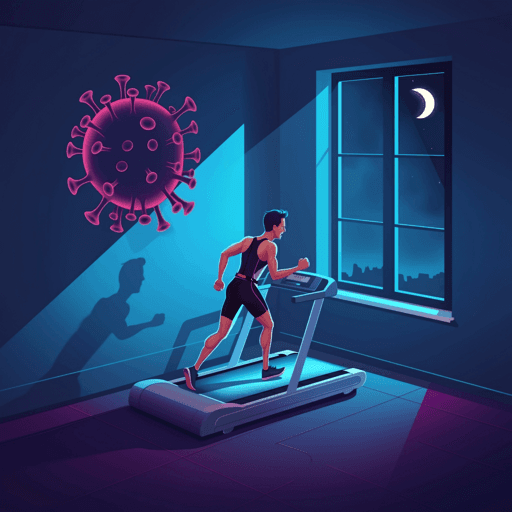
Health and Fitness
Evidence of Disturbed Sleep and Increased Illness in Overreached Endurance Athletes
C. Hausswirth, J. Louis, et al.
Endurance athletes who became functionally overreached during an overload training block showed objectively reduced sleep duration and efficiency and a higher rate of upper respiratory infections—effects that reversed during taper. Research conducted by Christophe Hausswirth, Julien Louis, Anaël Aubry, Guillaume Bonnet, Rob Duffield, and Yann Le Meur.
~3 min • Beginner • English
Introduction
Increasing training load can enhance adaptation and performance, yet an imbalance between stress and recovery can lead to functional overreaching (F-OR), characterized by transient performance decline that typically reverses after 1–3 weeks of recovery. The underlying causes of F-OR in endurance athletes remain uncertain. Sleep is recognized as a key recovery modality influencing cognitive and metabolic processes relevant to performance. While moderate physical activity is associated with better sleep, limited and equivocal evidence exists on sleep alterations during highly demanding training. Prior studies show mixed results and often lack objective sleep measures or clear overreaching diagnosis. Heavy training also depresses immune function, and modest sleep restriction elevates proinflammatory cytokines and increases susceptibility to URTI. The present study aimed to determine whether objective sleep parameters change in triathletes who develop F-OR during an overload training phase compared with controls and whether reduced sleep quality is accompanied by higher prevalence of URTI. The hypotheses were that F-OR would coincide with declines in sleep quality and quantity, and that F-OR athletes would show higher URTI prevalence.
Literature Review
The paper reviews evidence on training load and sleep: Taylor et al. reported increased movements during sleep at high training volumes in swimmers without clear F-OR; Fietze et al. found small reductions in sleep metrics in ballet dancers during high stress but without performance data. Self-reported sleep problems have been noted in athletes with overreaching/overtraining, yet objective evidence during confirmed F-OR is scarce. Regarding immunity, sustained heavy training depresses innate and adaptive immunity, and modest sleep restriction increases proinflammatory cytokines (Vgontzas et al.) and URTI risk (Cohen et al.), with lower sleep efficiency markedly increasing cold risk. These findings suggest sleep disturbances may mediate immunosuppression during overreaching, but no prior study directly linked F-OR, objective sleep disruption, and illness.
Methodology
Subjects: Forty well-trained male triathletes volunteered; after exclusions (injury/personal obligations, night work, equipment issues), 27 remained for analysis. All had ≥3 years competition history and trained ≥10 h·wk⁻¹. Ethics approval was obtained (Saint-Germain-en-Laye, no. 12048); participants underwent medical screening and provided informed consent.
Study design: Randomized matched-group design based on maximal aerobic power (MAP), habitual training volume, and experience assigned 9 to control (CTL) and 18 to overload. The 9-week protocol comprised a 3-week pretesting phase (usual training), then baseline (1 week with ~50% reduced volume, intensity maintained), an overload phase (3 weeks), and a taper (2 weeks with ~50% weekly reduction of normal load). Overload program increased session duration by ~30% relative to the normal training period; long cycling sessions could be split. The same weekly content was repeated across the 3 overload weeks; CTL continued habitual training. Testing occurred Pre (post-baseline), Mid (post-overload), and Post (post-taper), with 24-h rest before each test.
Training monitoring: Heart rate (HR) recorded every 5 s (Polar) during all sessions. Time spent in three HR zones was computed: ≤HR at 2 mmol·L⁻¹ lactate, between HR at 2 mmol·L⁻¹ and HR at lactate threshold, and >HR at lactate threshold. Reference HR values were reassessed after each lab test due to potential shifts with heavy training.
Laboratory testing and nutrition: Prior to each maximal incremental cycling test, participants followed standardized nutrition and hydration guidelines to ensure glycogen repletion. VO₂max and MAP were assessed on an electronically braked cycle ergometer (Lode Excalibur Sport) with a progressive protocol: 5 min at 100 W, 5 min at 150 W, 5 min at 200 W, then 25 W increments every 2 min to exhaustion. Breath-by-breath gas exchange (Cosmed Quark) was calibrated; VO₂max taken as the highest 30-s average. MAP calculated as MAP = Wcompl + 25(t/120), with Wcompl last completed workload and t seconds in the final stage. Lactate thresholds and HRs at 2 mmol·L⁻¹ and LT were derived using the modified D-max method.
Mood and fatigue: Profile of Mood States (POMS) assessed six mood dimensions; perceived fatigue was recorded before each lab test using a visual 0–100 analog scale.
Sleep monitoring: Continuous wrist actigraphy (Actiwatch; 1-min epochs) every night during baseline (7 d), overload (21 d), and taper (14 d). Participants completed daily sleep diaries (bedtime, sleep onset, wake time, get-up time) and marked lights-out and wake times via device button. Variables derived included time in bed, bedtime, get-up time, sleep latency, actual sleep time, sleep efficiency (%), fragmentation index, and immobile minutes. Perceived sleep quality was rated each morning on a seven-point scale from very, very good to very, very poor.
Illness monitoring: Weekly health questionnaires recorded URTI symptoms (e.g., sore throat, runny nose, cough, sneezing, fever, aches, headache) and gastrointestinal symptoms. Symptom severity (light/moderate/severe scored 1/2/3) contributed to weekly totals; a score ≥12 defined a URTI episode, separated by ≥1 week from another episode. Training impact (maintained/reduced/discontinued) was noted; medication use and doctor visits were reported.
Group classification and data handling: Overload group athletes were classified post hoc as functionally overreached (F-OR) if they showed decreased performance vs Pre and high perceived fatigue at Mid, with performance restoration or supercompensation at Post. Those with maintained or improved performance despite increased fatigue were classified acutely fatigued (AF). Sleep analyses used weekly mean values to improve reliability with extended monitoring.
Statistics: Normality tested via Kolmogorov–Smirnov. Baseline descriptive variables compared via one-way ANOVA. Two-way repeated-measures ANOVA (group × time) evaluated VO₂max, RPE/POMS, perceived sleep quality, and actigraphy outcomes; Greenhouse–Geisser corrections applied when sphericity was violated. Significant effects were followed by Duncan post hoc tests. Data are means ± SD.
Key Findings
- Overload response and classification: Of 18 overloaded athletes, 9 met F-OR criteria (performance decrease at Mid: −10 ± 4 W; VO₂max decrease at Mid; high POMS fatigue), with performance restored/supercompensated at Post (+5 ± 5 W). The other 9 were classified AF (no performance decline; performance increased at Mid and Post).
- Sleep parameters: Significant group × time interactions were found for actual sleep time (P = 0.02), sleep efficiency (P = 0.002), and immobile time (P = 0.006). Only the F-OR group showed progressive declines during overload, which reversed during taper:
• Actual sleep time: 6:36 ± 0:51 (baseline) → 6:05 ± 0:51 (overload week 3; P < 0.05) → 7:07 ± 0:49 (taper week 2; P < 0.05 vs overload).
• Sleep efficiency: 88.4% ± 1.7% (baseline) → 85.0% ± 1.7% (overload week 3; P < 0.05) → 89.4% ± 3.2% (taper week 2).
• Immobile minutes: 387 ± 53 (baseline) → 363 ± 53 (overload week 3; P < 0.05) → 418 ± 48 (taper week 2; P < 0.05 vs overload).
• Abstract-level changes across overload in F-OR: sleep duration −7.9% ± 6.7%, sleep efficiency −1.6% ± 0.7%, immobile time −7.6% ± 6.6% (all P < 0.05).
• No significant interactions for perceived sleep quality (P = 0.10), time in bed (P = 0.12), bedtime (P = 0.07), get-up time (P = 0.78), sleep latency (P = 0.13), fragmentation index (P = 0.07).
- Illness: Eight subjects reported at least one URTI episode during overload/taper. Incidence distribution: F-OR 67% (n = 6), AF 22% (n = 2), CTL 11% (n = 1). URTI occurrence peaked in the last week of overload, coinciding with maximal sleep disturbances in F-OR. No gastrointestinal discomfort was reported.
- Training adherence: AF and F-OR groups increased weekly training volume substantially versus CTL during overload (AF ~17 ± 3 h; F-OR ~19 ± 3 h; CTL ~12 ± 2 h; P < 0.001); intensity distribution was similar across groups.
Discussion
Objective actigraphy revealed that athletes who developed F-OR during overload exhibited moderate disturbances in sleep quality (lower sleep efficiency, fewer immobile minutes) and small reductions in sleep quantity (actual sleep time) which normalized during taper. These alterations were not observed in AF or control athletes, indicating a specific association between training maladaptation and sleep disruption. The lack of change in bedtime, time in bed, and sleep latency suggests reduced sleep efficiency—potentially due to difficulty maintaining immobility from fatigue or soreness—was the primary driver of reduced actual sleep time. Despite objective changes, perceived sleep quality did not significantly differ, highlighting a disconnect between subjective and objective measures.
The higher URTI prevalence in F-OR, particularly aligned with peak sleep disruption, supports proposed links between heavy training, sleep-related recuperative processes, and immune function. While causality cannot be inferred, the temporal association suggests that sleep disturbances may contribute to increased illness risk during periods of overreaching. The findings address the study’s hypotheses by demonstrating measurable sleep disruptions in F-OR and a concurrent elevation in URTI incidence.
Conclusion
Endurance athletes who develop functional overreaching during high-volume training display objectively measured reductions in sleep quality and quantity and an increased prevalence of URTI, which reverse with tapering. These results underscore the importance of monitoring sleep alongside performance and fatigue markers to identify training maladaptation. Practical recommendations include optimizing sleep environments (quiet, cool, dark), avoiding early-morning schedules during heavy training, and considering daytime naps to offset reduced nocturnal sleep. Future research should clarify causal pathways between sleep disturbances, overreaching, and immune outcomes, and determine whether targeted sleep interventions can mitigate training intolerance.
Limitations
- Causality cannot be established; sleep disturbance may be a symptom rather than a cause of F-OR or URTI.
- Sleep measured via wrist actigraphy, which estimates sleep rather than assessing sleep architecture (polysomnography); perceived sleep quality changes were small and not statistically significant.
- Sample size per subgroup was modest (n = 9), potentially limiting generalizability and statistical power.
- URTI diagnosis relied on symptom questionnaires and thresholds without clinical confirmation; medication use was recorded but not controlled.
- Participants were trained triathletes; findings may differ in elite or other sport populations.
- Moderate magnitude of sleep changes suggests extended monitoring may be required to detect F-OR-related sleep alterations reliably.
Related Publications
Explore these studies to deepen your understanding of the subject.







